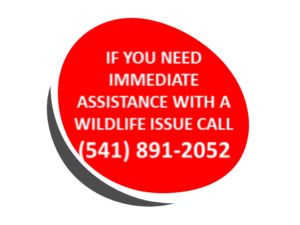FEEDING MEALWORMS TO SONGBIRDS (3/2021)
Here is some information regarding potential negative effects of feeding mealworms to songbirds. It is written by an ornithologist. We are providing this information as a public service announcement. Click this link to read. Mealworms
INJURED DEER (11/2019)
We get lots of calls about injured deer. Due to disease & overpopulation wildlife rehabilitators in our area are prohibited from interacting with deer by Oregon Fish & Wildlife. Badger Run respects this rule. We would lose our permits if we intervened with a deer & then be unable to help any animal. So what do you do if you have an injured adult deer?
The first thing to remember is that an adult deer cannot be rehabbed in captivity. It will die from the stress. With this in mind do not approach the deer nor attempt to give it food or water. Observe from a distance.
Many calls we receive regarding adult deer involve a broken leg. Believe it or not, 1 broken leg does not a dead deer make. If the deer is able to stand & is alert leave it alone. It will likely stay in the area for up to 3 weeks while the leg heals & will get up occasionally to forage. DO NOT give food or water. If the animal is not able to stand or raise its head & appears to be deteriorating over a 72 hour period if will need to be euthanized. Likewise, if more than 1 leg is broken it will need to be euthanized.
If euthanasia is required you will need to contact Oregon Fish & Wildlife OR Oregon State Police OR the Sheriff’s office.
ORPHANED BUNNIES (6/2015)
Baby bunnies are among the hardest animals to rehab. They are so easily stressed that 90% die in human care even under the best of circumstances. For that reason, it is imperative to realize that most “orphans” are not orphans at all.
So before you pick up a baby rabbit with the kind-hearted intention to help the little creature, remember the following facts:
- Mother jack rabbits only nurse their babies for a few minutes twice a day (morning & evening). Mother cottontails feed their babies intermittently thru the night & briefly in the morning to avoid drawing predators to the nest. The babies only appear abandoned and orphaned.
- Rabbit milk is VERY rich & the baby can fill up in a minute or so. Supplemental feeding by a rehabber cannot duplicate this. Rehabbers must feed a very specialized formula mixture every few hours to avoid starvation.
- Rabbits will still care for their babies even if they have been touched by human hands.
- If you find a nest that has been destroyed, you can move it or rebuild it to a safer area within 10 feet of it’s original location. Try to lay twigs around the nest so that you can see if the mother is returning.
- If you know for certain that the mother has been killed or the babies are in need of urgent help, contact a wildlife rehabilitator immediately.
- Baby rabbits are very cute and it is natural to want to handle them. However, they are very easily stressed by handling and noise. Any undue stress can cause them to have heart failure. They are wild animals. Individuals raising orphaned babies must not treat them as pets.
- There is a 90% mortality rate with orphaned baby rabbits in human care.
- For even more information you can check out this link. http://www.rainbowwildlife.com/baby-rabbit.htm
CHECK FOR NESTS BEFORE TRIMMING TREES & BUSHES (4/2015)
Orphaned baby birds are often brought to rehab facilities AFTER someone has inadvertently damaged or destroyed a nest site when trimming bushes, hedges, or trees. Nests are usually pretty well camouflaged so it’s important to carefully check for these prior to doing any Spring or Summer trimming. If you hire a landscaper make sure they take precautions as well. An easy way to avoid the problem is to do your pruning in the Fall. Also be aware that certain cavity nesters (like owls & woodpeckers) use hollow trees year around, not just for nesting. So it’s important to check hollow trees for occupants before cutting them down any time of year.
BE CAREFUL WHAT YOU FEED WATERFOWL (4/2015)
Soon our parks & surrounding lakes & rivers will be brim-full of baby ducks, geese, & swans. That’s why it’s important for people to learn about “ANGEL WING”. Angel wing is a wing deformity most commonly seen in waterfowl that is primarily caused by a poor diet in young, growing birds & usually results in an early death. Well-meaning folks feeding bread, popcorn, crackers, etc. to birds have unintentionally been killing them! If you feed these birds please make sure to feed nutritious waterfowl feed or duck pellets that are cheap, easy to carry, & available at most feed stores. Wildbird food, halved seedless grapes, earthworms, shredded kale, romaine, & chard can also be used. Just make sure to provide things in small bites to avoid choking hazards.
WHY DO RAPTORS GET HIT BY CARS SO OFTEN? (7/2014)
The most common injuries that we see at Badger Run result from birds being hit by cars. Raptors, ravens, magpies, & other bird species are opportunistic feeders. If road-kill is available, it’s a lot easier to feed on it than expend the energy to go hunting for other food. As a result, birds routinely feed on critters that have been killed on the roadways. They will gorge themselves to the point that they are not only heavier, but may be pretty lethargic (we call it Thanksgiving Turkey Syndrome). As a result, when they hear an approaching car they try to take off to get out of the way, but they tend to take off “low & slow”. This sets them up to be hit by the car. You can help prevent such collisions by slowing down when you see road-kill & watching carefully for birds & other wildlife that may be feeding on it.
WHY SHOULDN’T I USE POISON TO KILL RODENTS? (7/2014)
Unfortunately, people often turn to poisons to kill rats, mice, & ground squirrels that invade their homes, barns, & gardens. The unintended consequence of using the current 2nd generation ultra-potent rodenticides (such as d-Con, Hot Shot, Generation, Talon, & Havoc) is that they also poison anything that eats those invading rodents. As a result a poisoned rodent can also poison cats, dogs, owls, raptors, foxes, bobcats, & a number of other carnivores. Most of these poisons interfere with normal blood clotting & induce internal bleeding such that the animal bleeds to death over a period of hours or days. It is a terrible thing to witness. The following is from AudubonMagazine.org: “Of course, natural rodent control is not always available in heavily developed areas. Nor does it help much if rodents are multiplying inside your house. But that doesn’t mean you need weapons of mass destruction. Safe alternatives include single- and multiple-entrance snap traps, electrocuting traps, glue traps (provided you use them only indoors and frequently dispatch stuck rodents), and even first-generation baits with these active ingredients: chlorophacinone, diphacinone, diphacinone sodium salt, war-farin, and warfarin sodium salt. Then there’s the “better mouse trap.” You take a metal rod, run it through holes drilled in the center of both lids of an emptied tin soup can so the can becomes a spinning drum. Fasten both ends of the rod to the top of a plastic bucket via drilled holes. Coat the can with peanut butter, and fill the bucket with water and a shot of liquid soap (to break the surface tension and thus facilitate quicker, more humane drowning). Mice and rats jump onto the can, and it spins them into the water. The first time I deployed the device in my New Hampshire fishing camp, it killed 37 mice between Labor Day and Thanksgiving. Not only are these alternatives safer for people, pets and wildlife, they are, in the long run, more effective because they don’t take out the mammals and birds that keep rodents in check. With second-generation poisons you’ll get a spectacular initial kill. But a year or two later rodents will come storming back, as Jeannine Altmeyer can attest. You’ll then be fighting a war without allies.”
HOW DO BIRDS GET LEAD POISONING? (7/2014)
Eagles, vultures, loons, ducks, geese, & swans are the birds most commonly affected by lead poisoning. These species come in contact with lead by ingesting lead shot, lost fishing sinkers/tackle, or by eating dead or wounded prey containing lead shot or bullets. Lead poisoning mainly affects the central nervous system causing the birds to become so weak they cannot fly. Lead poisoning can also result in emaciation & cause kidney damage & anemia. Ingesting large amounts of lead can result in rapid death, but even small amounts of lead may be stored in the body resulting in a chronically ill bird that can suffer for months. Please use non-lead based fishing tackle & ammunition. The entrails left behind from a field dressed deer killed with lead ammunition can pose a lead risk to eagles & vultures. Burying these entrails can help reduce the risk to these birds.
WHY SHOULD I KEEP MY CAT INDOORS? (7/2014)
In January 2013 a new study was published in the journal, Nature Communications, indicating domestic cats kill wildlife (birds & mammals) at levels that have been grossly underestimated for decades. Based on research by scientists from the Smithsonian Conservation Biology Institute & U.S. Fish & Wildlife Service, it is now estimated that in the United States house cats are responsible for 1.3- 4 BILLION bird & 6-22 BILLION mammal deaths PER YEAR. Even the well-fed kitty will hunt wildlife. And they don’t have to actually kill the wildlife outright. A cat bite or scratch can set up a systemic infection that kills the bird or mammal later down the road. The BBC has reported that domestic cats have been responsible for the extinction of 33 species worldwide.
It is also healthier for your cat to be indoors. Outdoor cats can be hit by cars, attacked by dogs, other cats, or larger predators, & suffer from exposure to extreme weather. They can also contract fatal diseases, become lost/stolen, or be poisoned. The Humane Society estimates the average lifespan of an outdoor cat is only 3 years compared to 15 years for an indoor kitty.
HOW CAN PREVENT BIRDS FROM HITTING MY WINDOWS? (7/2014)
The key is to make your windows “apparent” rather than “transparent”.
- Locate feeders & birdbaths FAR AWAY from glass doors & windows. If, however, you want your feeders close to the windows for viewing move them within 3 feet of the window or put up a window feeder so that when the birds fly from the feeder they won’t be able to get up enough speed to harm themselves should they fly into the glass.
- Use window screens.
- Place decals on glass (use several for large windows). Some can be purchased that reflect UV light readily visible to birds, but are barely visible to humans.
- “Paint” windows with a fluorescent highlighter only visible to the birds (this fades within a few months & must be reapplied).
- Plant shade trees outside windows to reduce reflections.
- You can use interior vertical blinds leaving the slats open halfway.
- Occasionally you may have a nesting bird attack a window seeing its reflection as another bird. This goes on nonstop for weeks on end. Decals, scare tape, etc. may not work. Consider draping window screen material over the exterior of the window (or make a free standing screen) to block the window.
CAN FEEDING WILD BIRDS MAKE THEM DEPENDENT ON HUMANS? (7/2014)
No. You may have birds that regularly frequent a feeder, but wild birds eat a variety of foods & search these out in many places.
WHAT SHOULD I DO IF I FIND A BABY BIRD OUT OF THE NEST? (7/2014)
Baby birds begin to try “test flights” long before they are really ready to fly. In the perfect world, they jump/fly a few inches to the next branch, gradually increasing the distance until they are really capable of flight. In the real world, however, they often misjudge how far they can go, miss their mark and fall to the ground. This is a natural event which occurs in the wild frequently, but becomes a problem when these babies fall into our yards, populated by cats, dogs and kids.
If a baby bird has fallen to the ground, the best thing we can do is to put it back into its nest. If the nest is too high or otherwise unavailable, you can make a “surrogate nest” from a box, bucket, Tupperware, or whatever you have handy. It should be open on top and have sides at least 4 inches high. Drain holes are a nice addition. Line it with a soft cloth and hang it up as high as you can in a nearby tree or under the eaves of your house or garage, near where the baby was found. The important factors are that it is out of direct weather and high enough that cats, dogs, and kids can’t reach.
When the baby calls for food, mom or dad bird will come down and feed it. They don’t care that it’s in a “strange nest”; they will care for their offspring wherever it is. Don’t worry about “your scent”. Handling of their baby will not bother them at all.
As tempting as it is to “raise the cute baby”, this is not a good idea for many reasons. First, baby birds need to be fed every 15 minutes from sunrise to sunset, and need to be fed a diet that closely matches what their parents would be feeding them. As you can imagine, this can be a daunting task! Also, most parents spend weeks, months, even years teaching their babies how to hunt, what foods are good, and what foods are bad. As “surrogate parents”, we are simply not able to duplicate this training.
Obviously, if the baby is injured, it is time to call the Rehabilitator, but otherwise, let Mother Nature do her job and let these youngsters learn their life lessons from their parents, the best teachers they could have!
One final note: In the wild, breeding is all about getting your genes out there for many future generations. Often times, a mother bird becomes aware that one of her babies has a genetic defect that would compromise its chances for long- term survival. It sounds cruel, but a mother bird expends so much energy raising her young, she simply cannot waste that energy on an offspring that is not likely to survive to adulthood, so she may reject the baby, even throwing it out of the nest. We, well-meaning humans come along, do our best to save the baby, but despite our best efforts, mom does not return and the baby dies. It is important to remember that this is not a result of anything you did or did not do, it is a reality of nature.









Grandson and I were talking, do you take in youth raccoons if they become injured??
Oregon Fish & Wildlife does not allow us to admit any raccoons in this part of Oregon. It is due to disease & overpopulation. Be aware that raccoons usually carry a type of roundworm that doesn’t bother them, but can infect any other mammal. They shed it & in can invade your skin, your eye, or you brain. DIY rehab is also banned for these animals.